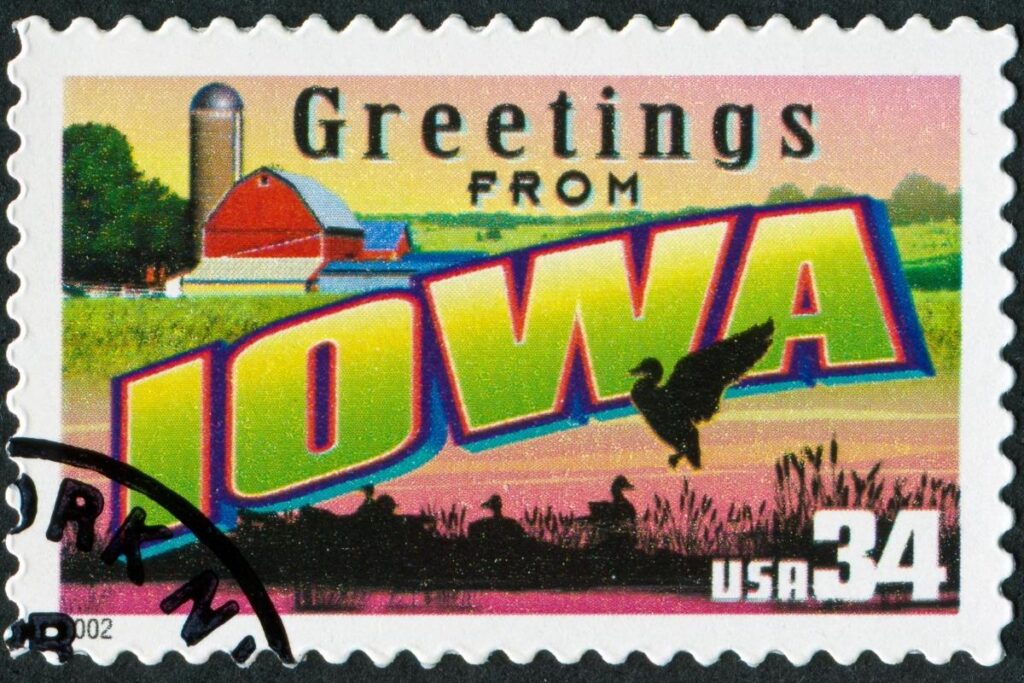
Living or visiting Iowa and wondering what bird you’re looking at? This article covers the most common birds of Iowa. Odds are high the bird you’re looking at is one of them. It will also inform you on how to identify them.
Birding in Iowa
With forests, farmland, natural wetlands, and the Missouri and Mississippi Rivers, Iowa has a variety of habitats for close to 400 species of many types of birds, especially birds along the riverbanks.
The Yellow River State Forest is home to songbirds such as warblers and tanagers. The Neal Smith National Wildlife Refuge has waterfowl as well as different types of sparrows and Bobolink.
Saylorville Reservoir north of Des Moines is the place to go for grebes, gulls, and terns by the lake and parks. There are Bald Eagles here throughout the year. Jester Park within the Reservoir has an abundance of shorebirds.
The Des Moines River flows through the Lacey-Keosauqua State Park with its many miles of birding trails. Birders are likely to spot Woodpeckers, Vireos, Warblers, Tanagers, and others.
Cone Marsh is located 20 miles from Iowa City with more than 220 species of birds. Birders need to be aware that this is a hunting zone. Geese, swans, ducks, cranes, and other shorebirds are common here.
Waubonsie State Park is a forested area in Loess Hills with seven miles of hiking trails, including a special trail that marks the park’s plants. Owls, wild turkeys, the White-breasted Nuthatch, and tanagers call this park home. Five miles away, birders will come across the Riverton Wildlife Management Area with its waterfowl, wading birds, and shorebirds. Bald Eagles are here in the winter.
Red Rock Reservoir is another Idaho area for waterfowls and wading birds. There are roads from the town of Pella leading through the reservoir.
DeSoto National Wildlife Refuge by DeSoto Lake is situated in both Iowa and Nebraska. There are 12 miles of roads through the refuge for access to the waterfowl here.
Dewey’s Pasture Bird Conservation Area includes plenty of wetlands inhabited by ducks, grebes, terns, bitterns, and others, including the Bald Eagle and Trumpeter Swan.
Common Birds of Iowa
Black-Capped Chickadee
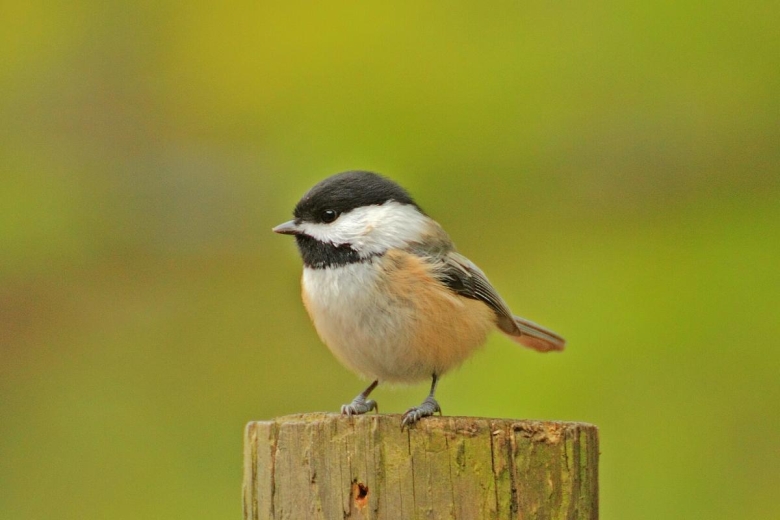
Black-capped Chickadee is a small bird with a big head with a short bill that can be found in Iowa all year. This bird is an elegant mixture of black and white, with a black cap and neck, white cheeks and white and gray wings, and a white and buff underbelly. They grow 4.7 to 5.9 inches in length and weigh 0.3 to 0.5 ounces with a wingspan between 6.3 to 8.3 inches. They live in woody and shrubby areas and will build their nest in birch or alder trees.
They feed on seeds, insects, and spiders and will visit backyards for suet, sunflower seeds, and peanut butter. They are an interesting bird species in that their brain neurons die every year and they are replaced with new ones, allowing the Chickadee to adapt easily to new circumstances.
Black-Billed Cuckoo
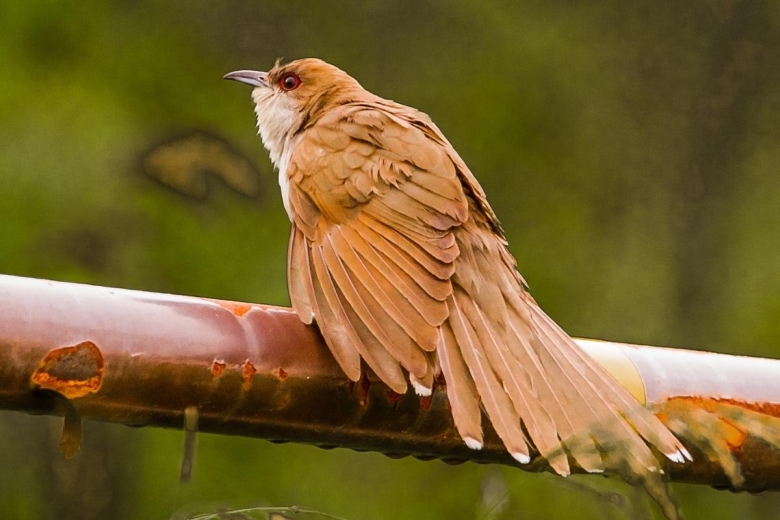
The Black-billed cuckoo is in Iowa between May and October. It is a slender bird with a long tail. It is plain brown on top and white on the bottom with distinctive red rings circling the eyes. The long tail has a white tip. Both sexes grow to 11.0 to 12.2 inches in length and weigh 1.4 to 2.3 ounces with a wingspan between 13.4 to 15.8 inches. They inhabit dense woods with deciduous and evergreen trees and like to remain hidden within dense vegetation while feeding on worms and caterpillars.
Northern Cardinal
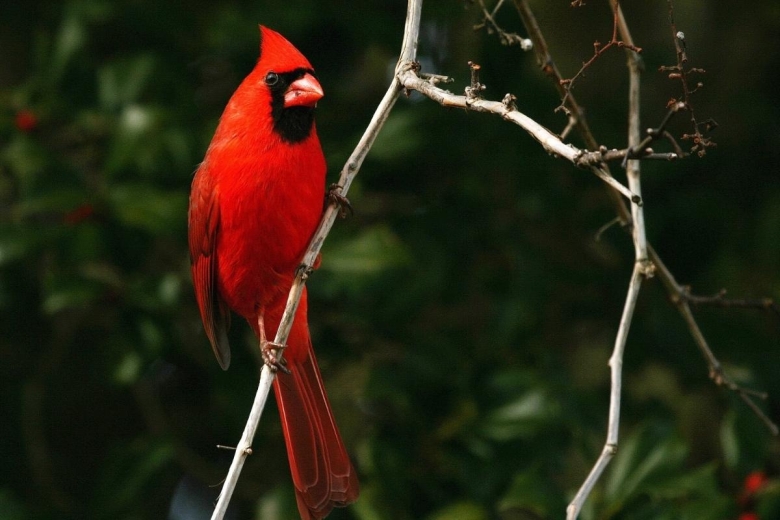
The Northern Cardinal lives in Iowa all year long. With its bright red feathers and jaunty rest crest, and a black mask above the red beak, this male beauty is a favorite among birders. The female is a light brown with a hint of red – if she’s lucky. She does have a red beak, and both have long tails and thick bills. Both sexes grow 8.3 to 9.1 inches in length and weigh 1.5 to 1.7 ounces with a wingspan between 9.8 and 12.2 inches. These cardinals live in parks, forest edges, and shrubby areas. They love peanuts, suet, and sunflower seeds.
Black Birds in Iowa
Bobolink
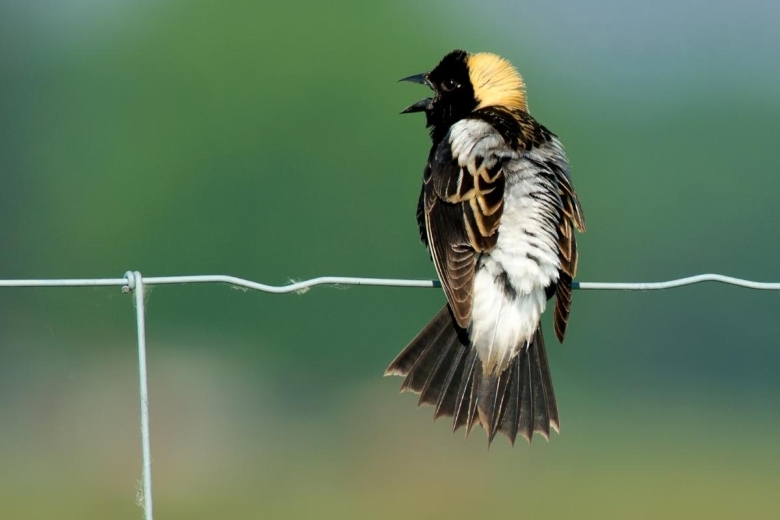
Bobolinks appear in Iowa from April to October. The male has a white back, black underbelly and a large orange cap on its head. The female has streaked brown wings, a pale belly, and a black streak down its head. They grow 5.9 to 8.3 inches in length and weigh 1.0 to 2.0 ounces with a wingspan of 10.6 inches. They inhabit marchland during breeding season and feed on seeds and insects.
Yellow-Headed Blackbird
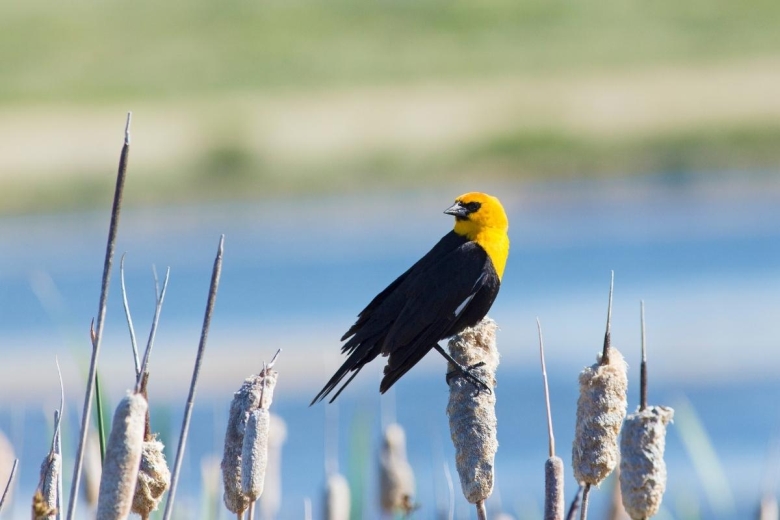
Yellow-headed Blackbirds can be spotted during the spring when they breed. They are a dramatic-looking blackbird with a shiny black body and a bright yellow head and chest and a black mask and thick bill. The female is brown instead of black. They grow to a length of 8.3 to 10.2 inches and weigh 1.6 to 3.5 ounces with a wingspan between 16.5 and 17.3 inches. They live in wetlands and grasslands where they forage insects.
Rusty Blackbird
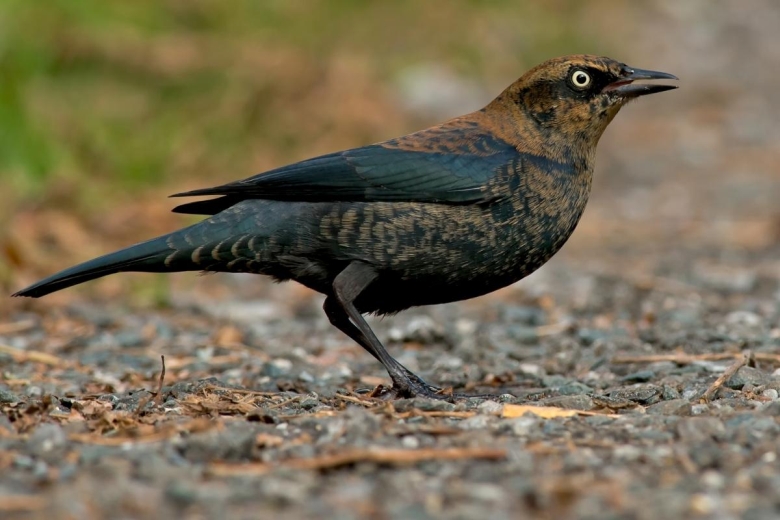
Rusty Blackbirds are in Iowa in September through May. The male is pure black. It is the female who has a rusty head and neck. They grow 8.3 to 9.8 inches in length and weigh 8.3 to 9.8 ounces with a wingspan of 14.6 inches. They inhabit swamps and bogs and anywhere wet while feeding on seeds, fish, and insects. They can be aggressive and eat other birds.
Blue Birds in Iowa
Eastern Bluebird
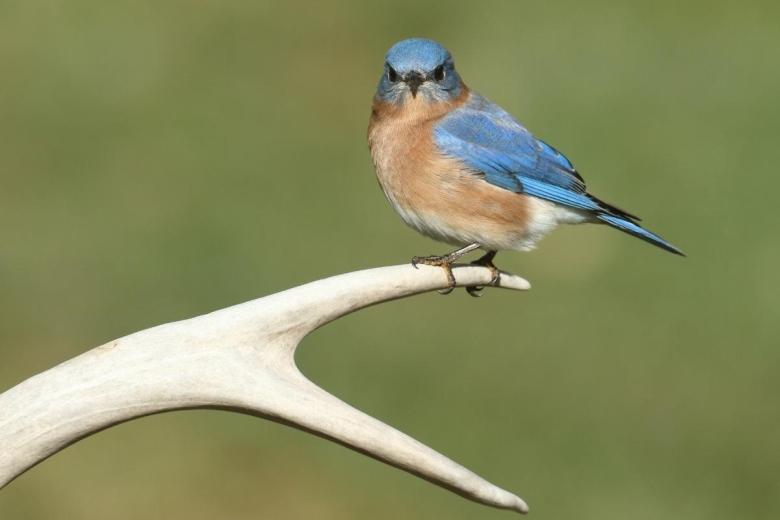
Eastern Bluebirds are in Iowa year-round and endure the cold winters, but most escape and return in March. They are small, plump birds with a large head, and short legs. Both sexes grow 6.3 to 8.3 inches in length and weigh 1.0 to 1.1 ounces with a wingspan between 9.8 and 12.6 inches. The male is a brilliant blue with an orange-rusty throat and chest. The female is gray with some blue in the wings and tail. Her throat and breast are a duller orange. They inhabit meadows and open areas such as golf courses. Most of their diet consists of berries, insects, and fruit.
Indigo Bunting
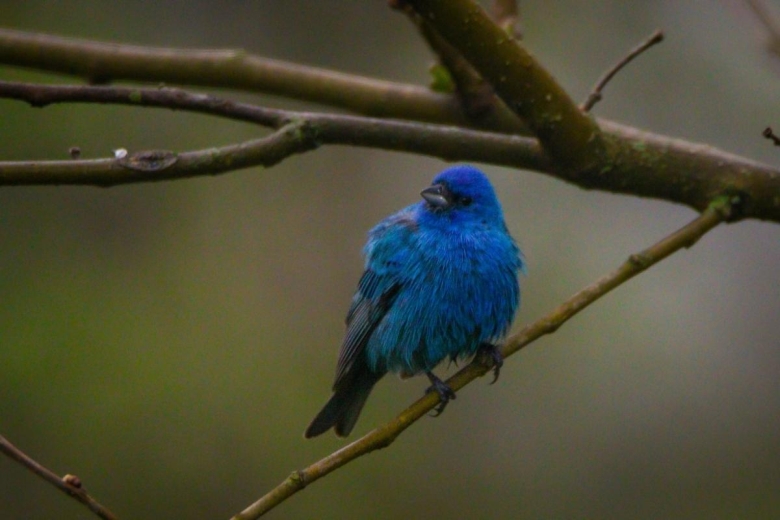
The indigo bunting graces Iowa with its beautiful presence from May through September. It is small and stocky with a short tail and bill. The male is a rich, all-over deep blue with a gray bill. The female is gray with some streaking on the wings and a pale underbelly. Both grow 4.7 to 5.1 inches in length and weigh 0.4 to 0.6 ounces with a wingspan between 7.5 to 8.7 inches.
Red Birds in Iowa
Scarlet Tanager
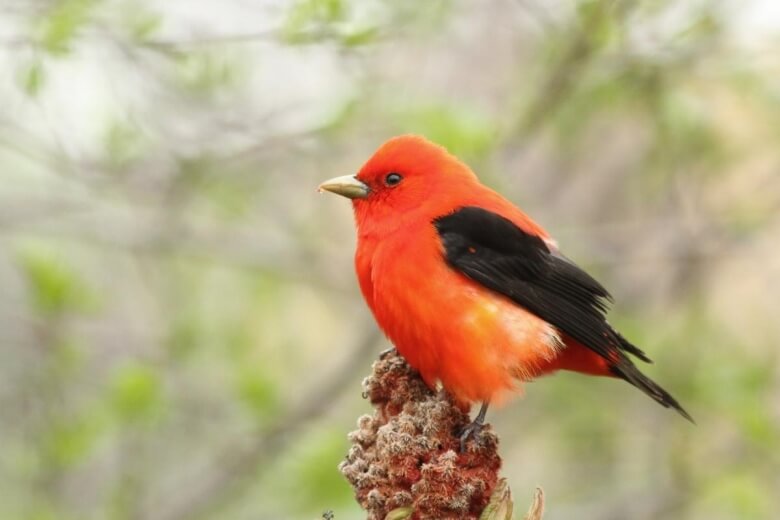
Scarlet Tanager is a stunner that spends the summer in Iowa. The male is a vivid red with contrasting black wings. The female is a dull shade of green-yellow. They both have thick, short bills, and a body that is almost round. Birders will find them a challenge because the Scarlet Tanager lives high in deciduous forest canopies, mostly out of sight. Their distinctive whistling songs may give away their location. They grow 6.3 to 6.7 inches in length and weigh 0.8 to 1.3 ounces with a wingspan between 9.8 to 11.4 inches. The Scarlet Tanager devours insects during the summer and also snaps up fruit in the winter.
Red-Bellied Woodpecker
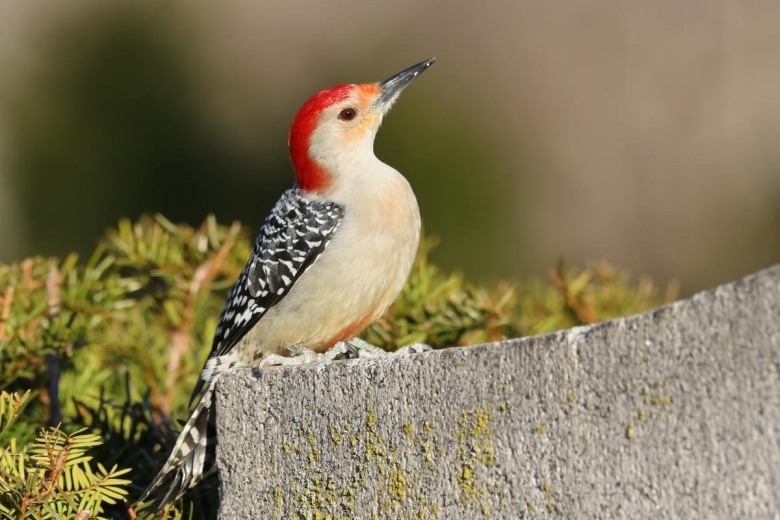
Red-bellied Woodpecker spends the entire year in Iowa, especially the eastern part of the state. The name is a bit of a misnomer. This woodpecker has a red strip across the head and a white belly with a hint of blush. The back, tail, and wings are a bold series of black and white stripes. They grow to 9.4 inches in length and weigh 2.0 to 3.2 ounces with a wingspan between 13.0 to 16.5 inches. They can be found in forests as well as backyards. The Red-bellied Woodpecker is an omnivorous eater, eating insects, nuts, seeds, fruits, and somethings bird eggs.
Rose-Breasted Grosbeaks
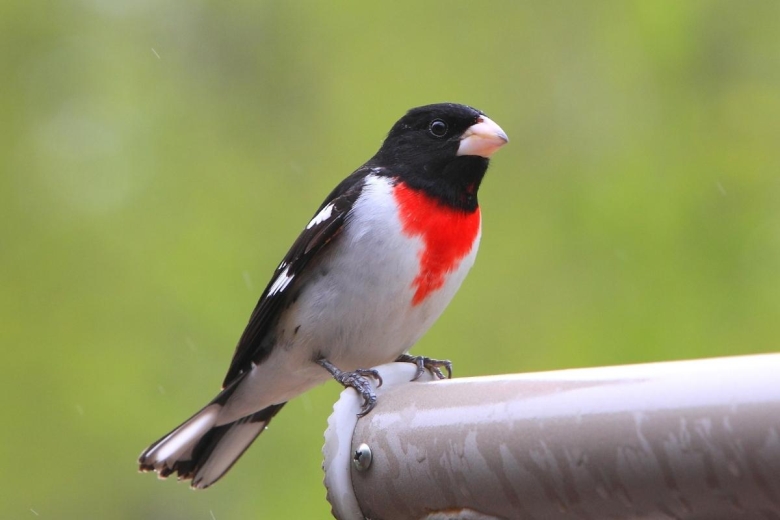
Rose-breasted Grosbeaks are a common sight in Iowa. They live in deciduous trees and snap up insects, seeds, and fruits. They specifically love sunflower seeds. The Rose-breasted Grosbeaks are stocky black and white with a distinctive red V down their chest. The female is a streaked brown with white eyebrows. Both grow 7.1 to 8.3 inches in length and weigh 1.4 to 1.7 ounces with a wingspan between 11.4 to 1.3 inches.
Orange Birds in Iowa
American Robin

American Robins arrive in Iowa in the spring, although a brave few manage the winter cold and feed on near-frozen berries. It is a large bird with long legs and a long tail. The male is a grayish color with streaked wings and white bits on the orange underbelly and rump. The head is dark, almost black, with a yellow beak.
Females are a paler gray. They grow 7.9 to 11.0 inches in length and weigh 2.7 to 3.0 ounces with a wingspan between 12.2 and 15.8 inches. The American Robin can be found in open areas such as parks, gardens, golf courses, and fields, as well as forests and shrublands where they forage the ground for their favorite food, earthworms.
Eastern Towhee

Eastern Towhee lives throughout Iowa, particularly around Lake Meyer Park, where they like to nest. They can be chunky with a long tail and a thick bill made to crack seeds. They grow 6.8 to 8.2 inches in length and weigh 1.1 to 1.8 ounces with a wingspan between 7.9 to 11.0 inches. The male has a black head, throat, and back, with a striped, black tail, white belly, and orange sides. The female is brown instead of black. They spend time in thickets and tangles with plenty of leaf litter, which they like to forage through for spiders and dropped seeds.
Barn Swallow
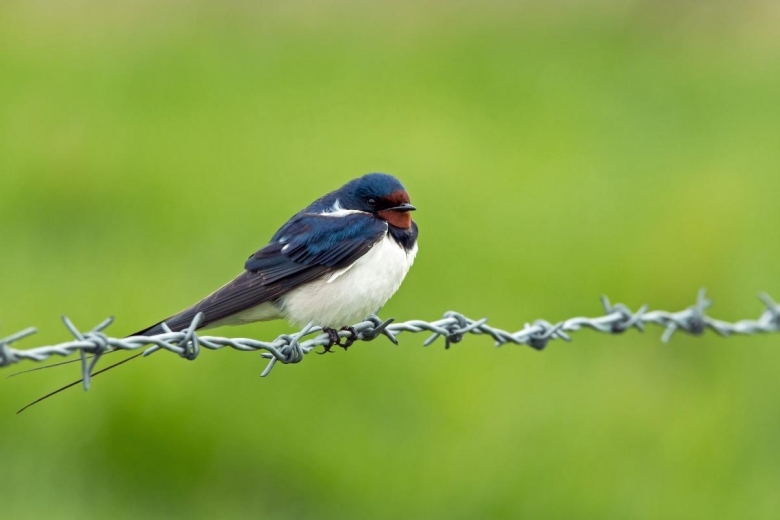
Barn Swallow is a common bird in Iowa and has lived on this continent – and others – before the evolution of mankind. That is one old bird. They have a blue back, wings, and a forked tail, with an orange underside. Their blue face melds into an orange throat, and they have an orange spot on top.
A white rump can be noticeable when the barn swallow is in flight. The colors of the male are bolder than those of the female. They grow 5.9 to 7.5 inches in length and weigh 0.6 to 0.7 ounces with a wingspan between 11.4 to 12.6 inches. They like open habitats such as meadows, fields, marshes, and coastal waters. As their name implies, they like to build their nests within barns and sheds. They feed on insects, bees, wasps, and spiders, with some occasional berries and seeds.
Yellow Birds in Iowa
American Goldfinch

American Goldfinch lives in Iowa throughout the year, but more can be spotted during the summer than at other times. They are a vivid yellow with a black forehead and black-streaked wings. The female is more brown than black. They grow 4.3 to 5.1 inches in length and weigh 0.4 to 0.7 ounces with a wingspan between 7.5 and 8.7 inches. They can be found in fields looking for sunflower seeds, thistle, and aster plants.
Cedar Waxwing

Cedar Waxwing can be seen in Iowa from the summer until the start of winter, although some do remain throughout the year. They are shades of elegant pastels, from a blush head and throat to light gray wings and tail and a pale yellow underbelly. Their most noticeable features are the bright red tip on the wings and the bright yellow tip on the tail, as well as the black mask over their eyes.
They grow 5.5 to 6.7 inches in length and weigh 1.1 ounces with a wingspan between 8.7 to 11.8 inches. They live in berry bushes (their main food source), grassland, and wetland. They love eating fruits and will add insects to their diet in the summer.
Dickcissel
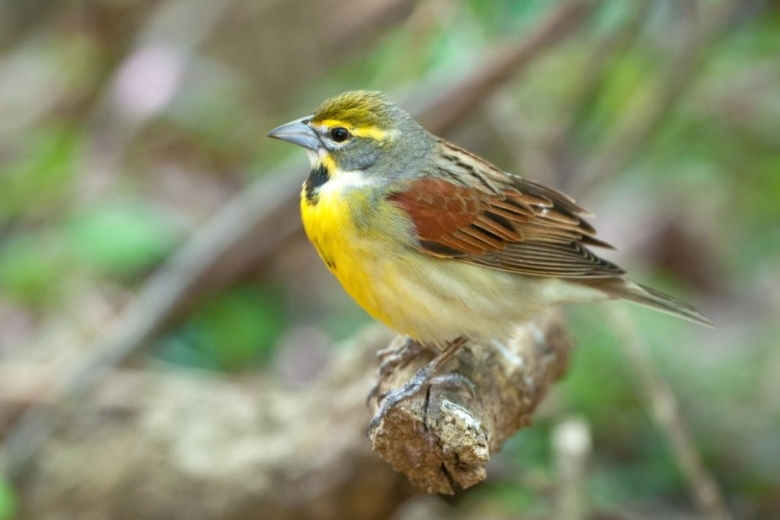
Dickcissels are common in Iowa’s rural areas. They are multi-colored, with a gray head, yellow eyebrows, a black throat, and a yellow chest. They grow 5.5 to 6.3 inches in length and weigh 0.9 to 1.4 ounces with a wingspan between 9.8 to 10.2 inches. They inhabit grassland and meadows. Their main diet during the summer consists of insects, and they forage for seeds during the winter.
Different Bird Species in Iowa
Shorebirds
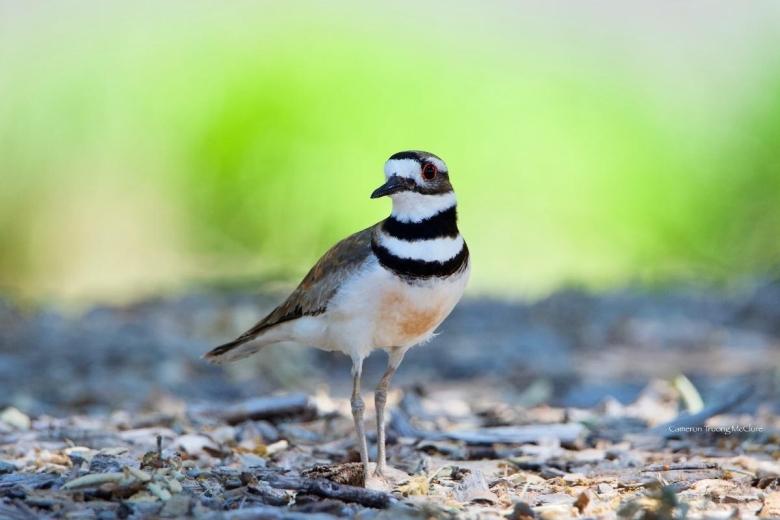
Killdeer – Charadrius vociferus – can be spotted along most of Iowa’s shoreline. They are slender with a long tail and wings, with light brown coloring on top and white underneath. The chest has two black bands, and the face has white patches. The wings are dark-brown with white bands. They grow 7.9 to 11.0 inches in length and weigh 2.6 to 4.5 ounces with a wingspan of 18.1 to 18.9 inches. They spend time on lawns, parking lots, or golf courses and spend less time by the water than most shorebirds. They feed on insects, snails, crayfish, and insect larvae.
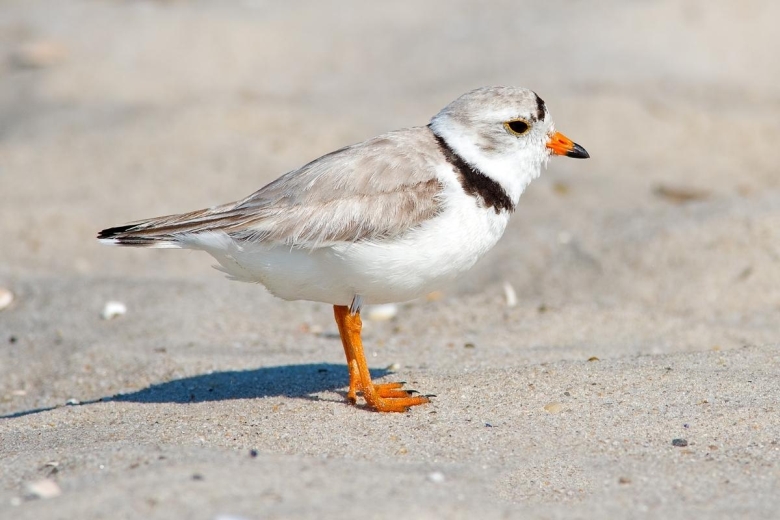
Piping Plover – Charadrius melodus – is the small Iowa plover that is becoming rarer in the state. It can be found breeding along the beaches of the Missouri River. They are small plovers with big, black eyes and a black streak on their forehead. The Piping Plovers are grayish in color with a light underbelly and orange bill and legs, and their neck has a black band that resembles a collar. Their coloring helps them blend into the shoreline and makes them difficult to spot. While bouncing through the sand, they forage for worms.
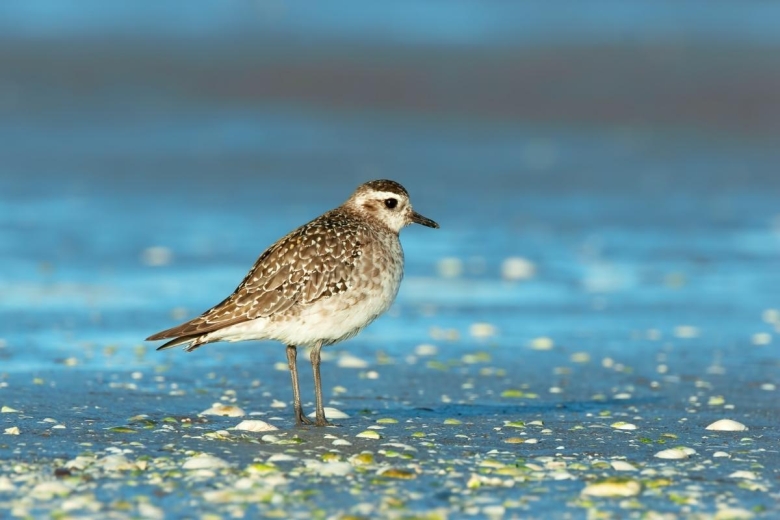
American Golden-Plover – Pluvialis dominica – is becoming rarer but can be spotted in the Mississippi Valley. They are medium-sized with a large head, thin neck, long legs, and long wings. Above, they have a dramatic gold-spangled design and are black below. Their faces are encircled with a thick, white band. They grow 9.4 to 11.0 inches in length and weigh 4.3 to 6.8 ounces with a wingspan between 25.6 and 26.4 inches. This plover hunts for insects in grassland.
Warblers in Iowa
The Iowa City Bird Club has a warbler walk on weekday mornings beginning at 6:30 a.m. from April through May.
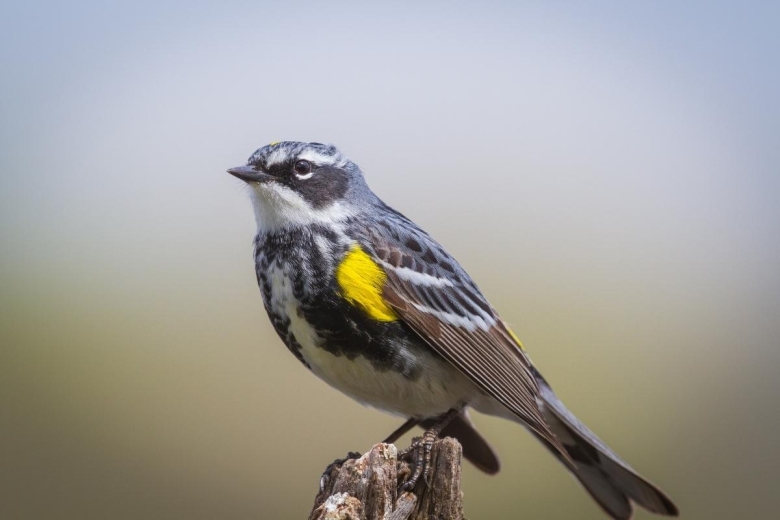
Myrtle Warbler – Setophaga coronata – lives in Iowa year-round. They have gray and white wings and a blackish chest. Their rump and some wing features are yellow, as is a small spot on their head, which is why they are also known as the Yellow-rumped Warbler. They grow 4.7 to 5.5 inches in length and weigh 0.4 to 0.5 ounces with a wingspan between 7.5 and 9.1 inches. They inhabit both coniferous and deciduous forests and tend to move toward shrubby terrain in the winter. They feed on insects and berries.
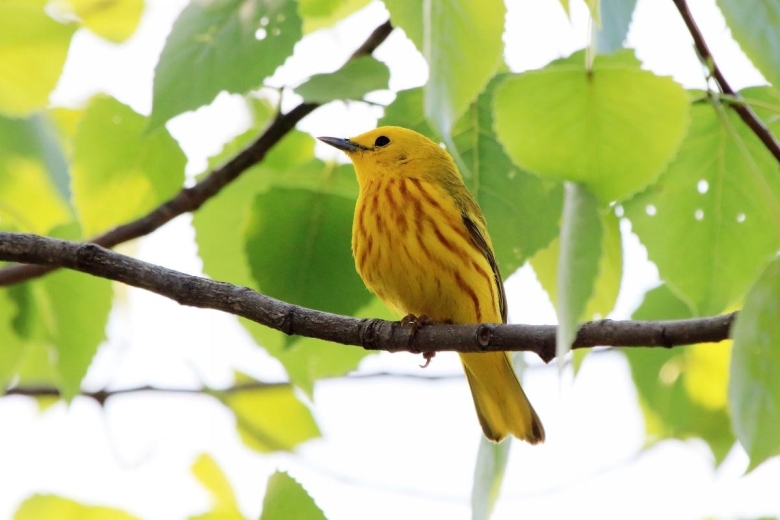
American Yellow Warbler – Setophaga petechia – is a resident of Iowa during the summer months. This canary almost-look-alike is a bright yellow small songbird with a thin bill. There are some faint brownish streaks through the wings and belly. They grow to a length of 4.7 and 5.1 inches and weigh 0.3 to 0.4 ounces with a wingspan between 6.3 and 7.9 inches. They inhabit shrubby areas and spring from branch to branch foraging the bark for insects and caterpillars. Despite living in trees, they nest at the base of trees.
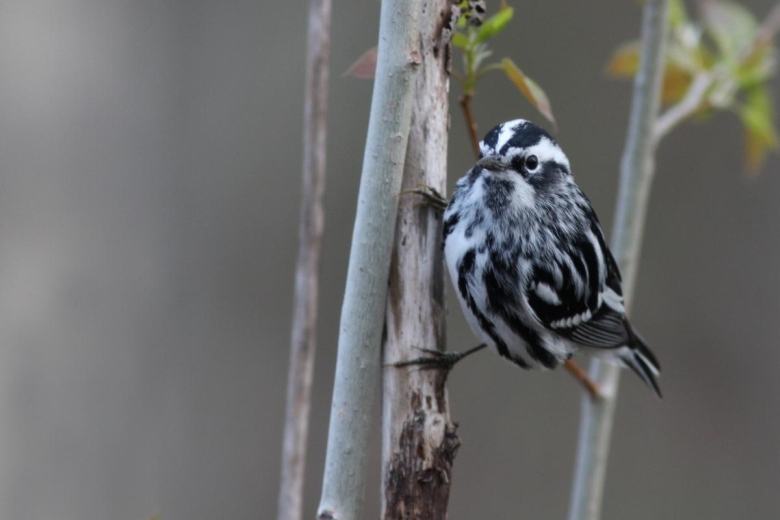
Black-and-white Warblers migrate through Iowa during the summer from May through September. This medium-sized bird has a bold and elegant black and white striped design. The long black wings have two white bars and a black head melting into a white throat. They grow 4.3 to 5.1 in length and weigh 0.3 to 0.5 ounces with a wingspan between 7.1 and 8.7 inches. They live in deciduous and mixed forests and forage through the bark for insects.
Hawks in Iowa
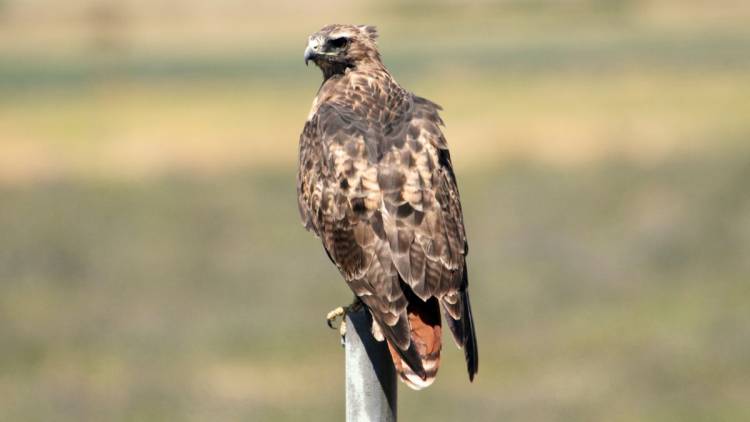
Red-Tailed Hawk – Buteo jamaicensis – is a common Iowa hawk whose nests can be found along Interstate 35 to the Missouri border. They are broad with a short and wide tail and are the second-largest hawk in the U.S. Red-tailed Hawks are a deep brown above and a paler, streaked brown below with streaked wings. They derive their name from the cinnamon-reddish color above the tail.
The male grows to 17.7 to 22.1 inches and weighs 24.3 to 45.9 ounces with a wingspan between 44.9 to 52.4 inches. The larger female grows to 19.7 to 25.6 inches and weighs 31.8 to 51.5 ounces with a wingspan similar to the male. They soar through the air, then dive for their prey. They live in open country and perch on telephone poles and fenceposts in search of small mammal for food.

Northern Goshawk – Accipiter gentilis – can be spotted in Iowa from September through March. However, they protect their privacy and will hide in dense forests. They are large, with broad wings and a long tail. Their back is a dark gray above with a paler gray underbelly, with some streaking. There is a white strip over their head, and they have red eyes.
These hawks grow 20.9 to 25.2 inches in length and weigh 22.3 and 48.1 ounces with a wingspan between 40.5 and 46.1 inches. They soar down from high up and crush their quarry – smaller mammals – within their talons. They are fiercely protective of their habitat and will attack in defense. To put it in perspective, Attila the Hun wore an emblem of the Northern Goshawk.
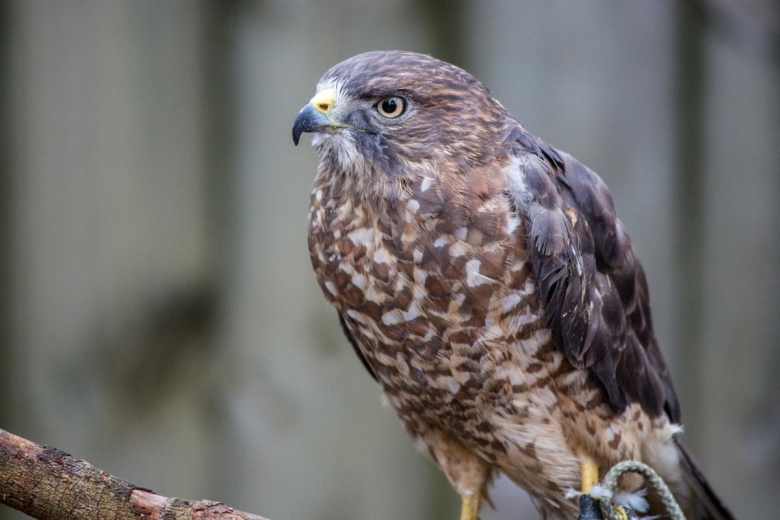
Broad-Winged Hawk – Buteo platypterus – lives in Iowa during the summer but migrates south when it begins to get cold. It is small, compact, and chunky with a short, square tail. Their heads are rusty while their chest and underbelly are speckled. The wings have a distinctive brown border, and there are black and white bands around the tail.
They grow 13.4 to 17.3 inches in length and weigh 9.3 to 19.8 ounces with a wingspan between 31.9 and 39.4 inches. They soar over and perch on the forest canopy. They are fairly omnivorous and will swoop down to the ground for small rodents, mammals, birds, insects, and amphibians.
Further Reading on Birding in Iowa
For more information about Iowa birding, consider the following books:
- Used Book in Good Condition
- Tekiela, Stan (Author)
- Parnell, Marc (Author)
- English (Publication Language)
Birders can also check the following sources for more information:


